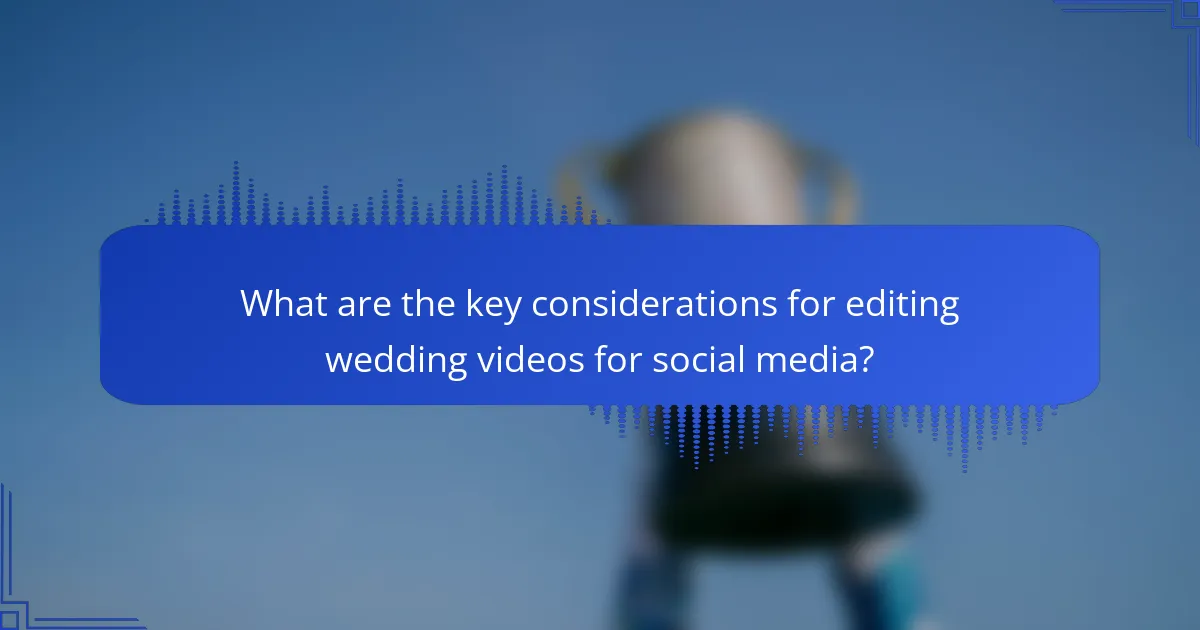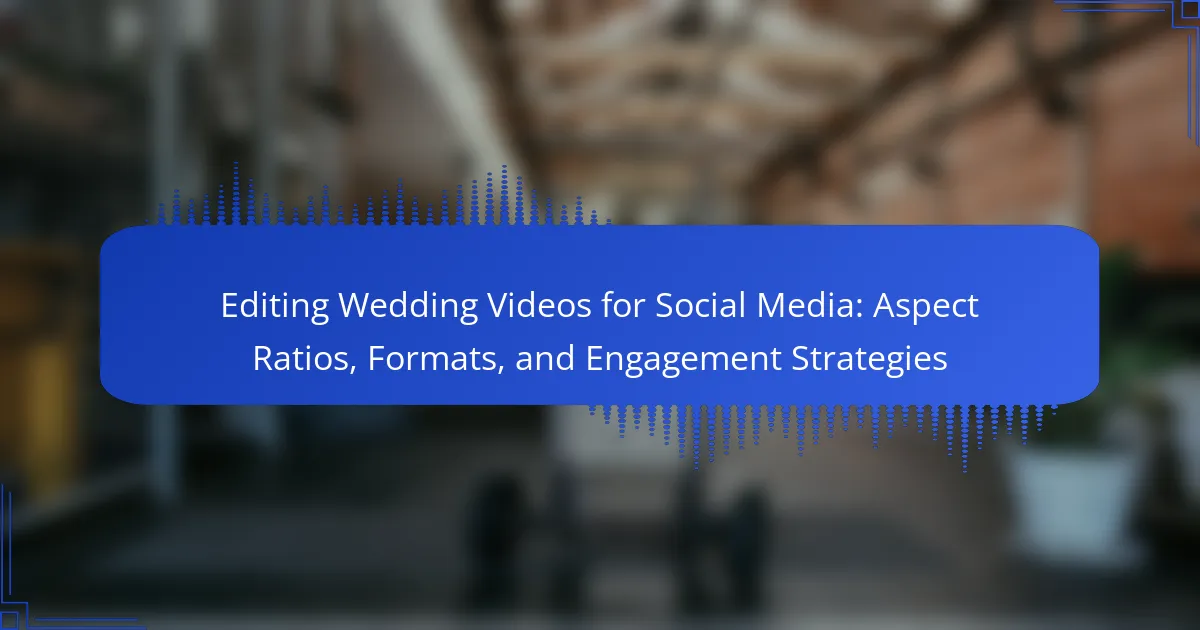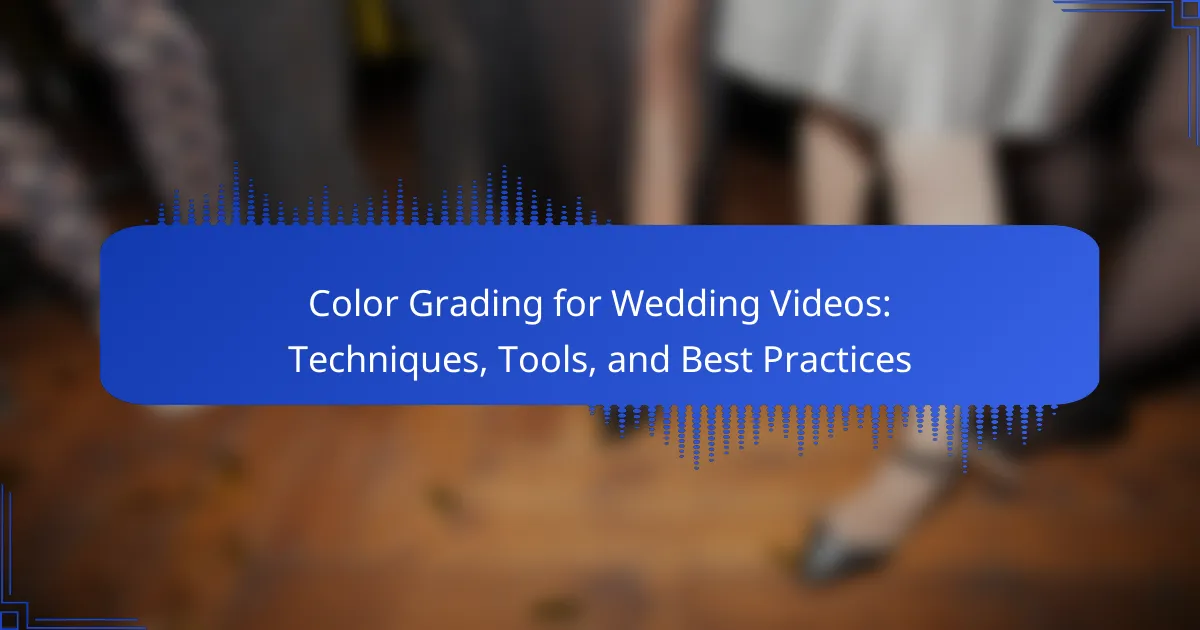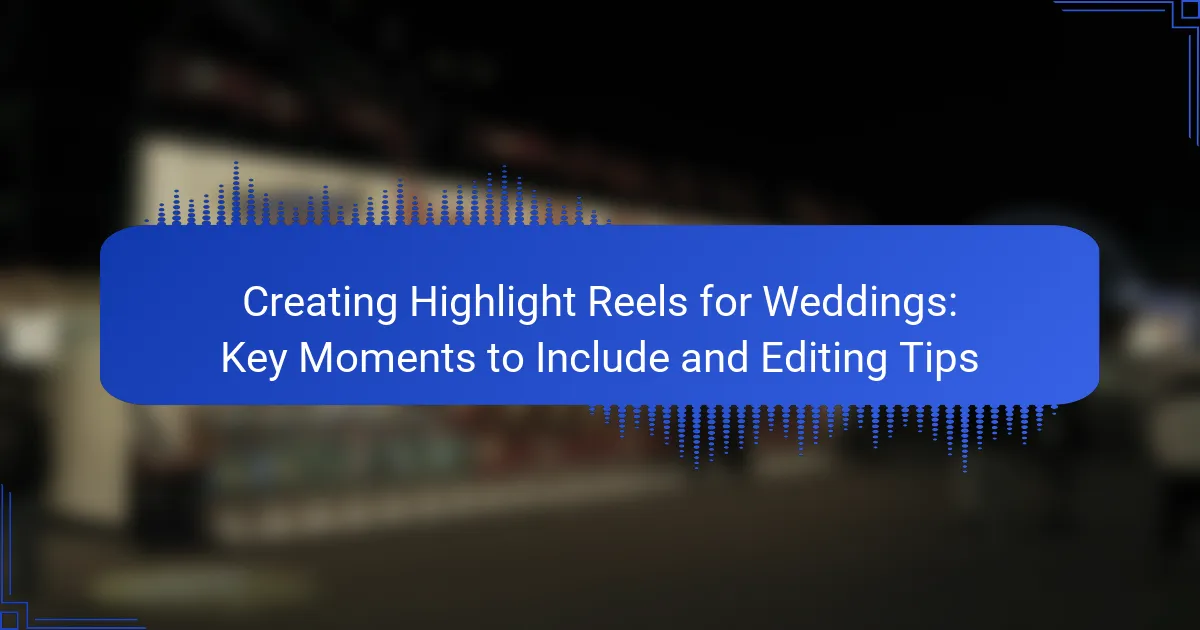Editing wedding videos for social media involves several key considerations, including aspect ratios, video length, and engagement strategies. Optimizing aspect ratios, such as 1:1 for Instagram and 16:9 for YouTube, is essential for platform compatibility. Video length should be kept between 30 to 60 seconds for better performance on platforms like Instagram and TikTok. Engaging content, featuring highlights, emotional moments, and testimonials, enhances viewer connection, while captions improve accessibility. High-quality visuals and sound are also crucial for maintaining a professional standard in wedding video editing.

What are the key considerations for editing wedding videos for social media?
Key considerations for editing wedding videos for social media include aspect ratio, video length, and engagement strategies. Aspect ratios should be optimized for the platform, such as 1:1 for Instagram and 16:9 for YouTube. Video length is crucial; shorter clips, around 30 to 60 seconds, tend to perform better on platforms like Instagram and TikTok. Engaging content is necessary; incorporating highlights, emotional moments, and testimonials can enhance viewer connection. Additionally, using captions can improve accessibility and engagement. Finally, ensure high-quality visuals and sound to maintain professionalism.
How do aspect ratios influence the presentation of wedding videos?
Aspect ratios significantly influence the presentation of wedding videos. They determine how the visuals are framed and perceived by the audience. Common aspect ratios include 16:9, 4:3, and 1:1. The 16:9 ratio is ideal for widescreen viewing, providing a cinematic experience. In contrast, the 4:3 ratio is more traditional and can create a nostalgic feel. The 1:1 ratio is popular for social media platforms, ensuring the video looks good on mobile devices. Choosing the right aspect ratio enhances viewer engagement. It aligns with the platform’s requirements, maximizing reach and impact. For example, Instagram favors square or vertical videos. This adaptability influences how well the content resonates with viewers.
What are the most popular aspect ratios for social media platforms?
The most popular aspect ratios for social media platforms are 1:1, 4:5, and 16:9. The 1:1 ratio is widely used on platforms like Instagram for posts. The 4:5 ratio is preferred for Instagram portraits, maximizing screen space. The 16:9 ratio is commonly used for videos on platforms like YouTube and Facebook. These ratios optimize visual engagement and user experience. Research indicates that posts with optimal aspect ratios receive higher interaction rates. For instance, square videos can yield 30% more views compared to landscape formats on social media.
How can choosing the right aspect ratio enhance viewer engagement?
Choosing the right aspect ratio can significantly enhance viewer engagement. The aspect ratio affects how content is displayed on different platforms. For instance, a 16:9 ratio is ideal for YouTube, while a 1:1 ratio works well on Instagram. Tailoring the aspect ratio to the platform increases visibility and accessibility. Research shows that videos optimized for mobile viewing, typically 9:16, can lead to higher engagement rates. A study by Wistia indicates that videos in the correct aspect ratio can retain viewers’ attention longer. Therefore, selecting the appropriate aspect ratio is crucial for maximizing viewer interaction and satisfaction.
What video formats are best for sharing wedding videos on social media?
The best video formats for sharing wedding videos on social media are MP4 and MOV. MP4 is widely supported across various platforms and maintains high quality while compressing file size. MOV is favored for its superior quality, particularly on Apple devices. Both formats are compatible with major social media platforms like Facebook, Instagram, and YouTube. MP4 files typically use H.264 codec, ensuring efficient compression without significant quality loss. This makes them ideal for quick uploads and streaming. MOV files, while larger, offer better editing flexibility for post-production. According to social media guidelines, using these formats enhances user experience and engagement.
What are the differences between common video formats like MP4 and MOV?
MP4 and MOV are both popular video formats with distinct differences. MP4 is widely used for its compatibility across various devices and platforms. It efficiently compresses video without significant loss of quality. MOV is primarily associated with Apple’s QuickTime framework. It supports higher quality video and audio but may result in larger file sizes. MP4 files are ideal for streaming and sharing online due to their smaller size. MOV files are often preferred for professional editing and high-quality storage. The choice between them depends on the intended use and required quality.
How do video formats affect quality and compatibility with social media?
Video formats significantly affect quality and compatibility with social media. Different formats like MP4, AVI, and MOV have varying levels of compression and quality. MP4 is widely supported and maintains high quality with smaller file sizes. Social media platforms often have preferred formats; for example, MP4 is favored by Facebook and Instagram. Using unsupported formats can lead to playback issues or poor quality. Additionally, resolution and bitrate influence how well videos perform on social media. Higher resolutions generally provide better quality but may not be compatible with all platforms. Therefore, selecting the right video format is crucial for optimal viewing experiences on social media.
What engagement strategies can be used when editing wedding videos?
Engagement strategies for editing wedding videos include using storytelling techniques, dynamic transitions, and personalized content. Storytelling techniques create an emotional connection by highlighting key moments. Dynamic transitions keep the viewer’s attention and enhance visual flow. Personalized content, such as including messages from the couple, increases relatability. Additionally, incorporating music that resonates with the couple’s journey can enhance engagement. Using shorter clips for social media platforms captures attention quickly. These strategies collectively improve viewer retention and interaction.
How can storytelling techniques enhance wedding video engagement?
Storytelling techniques can enhance wedding video engagement by creating a narrative that resonates with viewers. A compelling story captures attention and evokes emotions. Techniques such as chronological storytelling, highlighting key moments, and incorporating interviews can create a relatable experience. For instance, using voiceovers to narrate the couple’s journey adds depth. Incorporating visual elements like flashbacks or montages can further engage the audience. Research shows that videos with strong narratives retain viewer interest longer. According to a study by Wistia, videos that tell a story can increase viewer retention by up to 80%. Thus, storytelling techniques significantly boost engagement in wedding videos.
What role does music selection play in viewer engagement?
Music selection significantly enhances viewer engagement by creating emotional connections. The right music can evoke specific feelings and set the tone of the video. Studies show that videos with appropriate background music hold viewer attention longer. For instance, research indicates that emotional music can increase viewer retention by up to 60%. Additionally, music can influence the perceived quality of the video content. A well-chosen soundtrack can elevate the overall experience, making it more memorable. This is particularly important in wedding videos, where emotional resonance is key. Therefore, music selection is crucial for maximizing viewer engagement and enhancing the storytelling aspect of the video.
How can you effectively transition between different video formats and platforms?
To effectively transition between different video formats and platforms, first identify the required format specifications for each platform. Each platform, such as Instagram, Facebook, or YouTube, has unique aspect ratios and file types. For example, Instagram prefers square or vertical videos, while YouTube favors horizontal formats.
Next, use video editing software to adjust the aspect ratio accordingly. Tools like Adobe Premiere Pro or Final Cut Pro allow for easy resizing and format conversion. Export the video in the recommended settings for each platform to ensure optimal quality.
Additionally, consider the audience engagement strategies specific to each platform. Tailor the content style and length based on platform norms. For instance, shorter videos may perform better on TikTok compared to longer formats on YouTube.
Finally, test and monitor the performance of videos across platforms. Analyze viewer engagement metrics to refine future transitions and content strategies.
What tools are available for editing wedding videos for social media?
Popular tools for editing wedding videos for social media include Adobe Premiere Pro, Final Cut Pro, and iMovie. Adobe Premiere Pro offers advanced features for video editing and is widely used by professionals. Final Cut Pro is favored by Mac users for its intuitive interface and powerful capabilities. iMovie provides a user-friendly option for beginners with essential editing tools. Other notable tools include DaVinci Resolve, which is known for its color grading features, and Filmora, which offers a range of templates and effects. These tools support various aspect ratios and formats suitable for platforms like Instagram and Facebook.
What are the best editing software options for beginners?
The best editing software options for beginners include iMovie, Adobe Premiere Rush, and Filmora. iMovie is user-friendly and available on Mac devices. It offers essential editing tools and templates. Adobe Premiere Rush provides a simplified version of Premiere Pro, suitable for quick edits on mobile and desktop. Filmora features an intuitive interface with drag-and-drop functionality. These software options are designed to make video editing accessible for those new to the craft. Each program includes tutorials and support, enhancing the learning experience for beginners.
How can advanced editing techniques improve the final product?
Advanced editing techniques can significantly enhance the final product by improving visual appeal and storytelling. These techniques include color grading, transitions, and audio synchronization. Color grading adjusts the mood and tone of the video, making it more engaging. Smooth transitions maintain viewer interest and create a professional look. Audio synchronization ensures that sound aligns perfectly with visuals, enhancing the overall experience. Research shows that well-edited videos increase viewer retention by up to 60%. This retention is crucial for social media engagement, where attention spans are short. Thus, advanced editing techniques lead to a more polished and captivating wedding video.
What are best practices for maximizing engagement with wedding videos on social media?
To maximize engagement with wedding videos on social media, use short, captivating clips. Videos should be under one minute for platforms like Instagram and TikTok. Incorporate trending music to enhance emotional appeal. Utilize engaging captions and hashtags to increase discoverability. Post during peak times when your audience is most active. Encourage viewer interaction by asking questions in your captions. Share behind-the-scenes footage to create a personal connection. Analyze engagement metrics to refine future content strategies.
The main entity of the article is editing wedding videos for social media. The article provides essential considerations for optimizing wedding video content, focusing on aspect ratios, video formats, and engagement strategies tailored for various social media platforms. Key topics include the significance of choosing appropriate aspect ratios for viewer engagement, the best video formats for sharing, and effective editing techniques that enhance storytelling and emotional connection. Additionally, the article outlines best practices for maximizing audience interaction through strategic content creation and analysis of engagement metrics.



